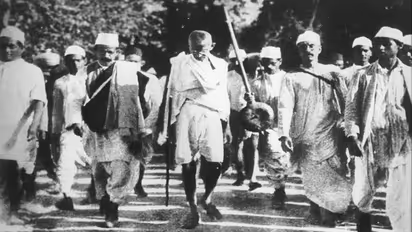India@75 moments: Know about Dandi March led by Mahatma Gandhi against salt tax

Synopsis
The British had long had a profitable monopoly on salt manufacture and delivery in India. Through a series of legislation, the Indian population was barred from making or selling salt on their own, and instead, Indians were forced to buy expensive, heavily taxed salt that was frequently imported.
The Salt March, also known as the Dandi March or the Salt Satyagraha, was a large nonviolent protest conducted by in March–April 1930. The march was the first step in Gandhi's broader campaign of civil disobedience against British authority in India, which lasted until early 1931 and won Gandhi great support among the Indian people as well as substantial international attention.
The British had long had a profitable monopoly on salt manufacture and delivery in India. Through a series of legislation, the Indian population was barred from making or selling salt on their own, and instead, Indians were forced to buy expensive, heavily taxed salt that was frequently imported. This impacted the vast majority of Indians, who were poor and unable to purchase it. Protests against the salt tax in India began in the nineteenth century and were a major source of contention throughout the subcontinent's British administration.
In early 1930, Gandhi resolved to stage a very conspicuous protest against the increasingly harsh salt tax by marching from his ashram (religious retreat) at Sabermati (near Ahmadabad) to the town of Dandi (near Surat) on the Arabian Sea coast. On March 12, he headed out on foot, accompanied by a group of several dozen followers. After each day's march, the party would halt in a new village along the road, where ever-larger crowds would assemble to hear Gandhi rage about the unfairness of the tax on the poor.
Hundreds more would join the main group of followers as they made their way to the sea, until the entourage arrived at Dandi on April 5 after a 240-mile trek (385 km). Gandhi and his supporters gathered up handfuls of salt along the coast on April 6, technically "manufacturing" salt and breaching the law.
Also Read | India@75 moments: 1942, the year Indian National Army was formed
There were no arrests made that day, and Gandhi continued his satyagraha against the salt tax for the next two months, encouraging other Indians to defy the salt regulations via acts of civil disobedience. Thousands of people were arrested and imprisoned, including Jawaharlal Nehru in April and Gandhi himself in early May, when he told Lord Irwin (India's viceroy) of his intention to march on the adjacent Dharasana saltworks. Tens of thousands more joined the satyagraha after learning of Gandhi's arrest. On May 21, the poet Sarojini Naidu organised a march to the saltworks, and many of the 2,500 nonviolent protesters were assaulted and beaten by police.
Gandhi was freed from prison in January 1931 and began talks with Lord Irwin to halt the satyagraha movement. Following it, a truce was announced, which was formalised in the Gandhi-Irwin Pact, which was signed on March 5. The de-escalation of hostilities allowed Gandhi, representing the Indian National Congress, to join the Round Table Conference's second session (September–December 1931) in London.
Also Read | India@75 moments: The non-cooperation movement of 1920
Also Read | India@75 moments: The Quit India Movement that united Indian people against British rule